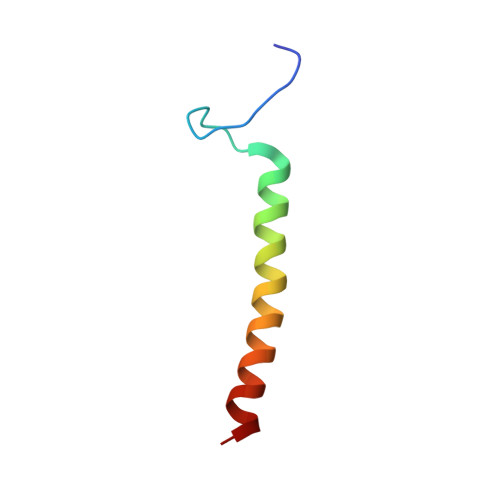Structural basis of the signal transduction via transmembrane domain of the human growth hormone receptor.
Bocharov, E.V., Lesovoy, D.M., Bocharova, O.V., Urban, A.S., Pavlov, K.V., Volynsky, P.E., Efremov, R.G., Arseniev, A.S.(2018) Biochim Biophys Acta 1862: 1410-1420
- PubMed: 29571748
- DOI: https://doi.org/10.1016/j.bbagen.2018.03.022
- Primary Citation of Related Structures:
5OEK, 5OHD - PubMed Abstract:
Prior studies of the human growth hormone receptor (GHR) revealed a distinct role of spatial rearrangements of its dimeric transmembrane domain in signal transduction across membrane. Detailed structural information obtained in the present study allowed elucidating the bases of such rearrangement and provided novel insights into receptor functioning. We investigated the dimerization of recombinant TMD fragment GHR 254-294 by means of high-resolution NMR in DPC micelles and molecular dynamics in explicit POPC membrane. We resolved two distinct dimeric structures of GHR TMD coexisting in membrane-mimicking micellar environment and providing left- and right-handed helix-helix association via different dimerization motifs. Based on the available mutagenesis data, the conformations correspond to the dormant and active receptor states and are distinguished by cis-trans isomerization of Phe-Pro 266 bond in the transmembrane helix entry. Molecular dynamic relaxations of the structures in lipid bilayer revealed the role of the proline residue in functionally significant rearrangements of the adjacent juxtamembrane region supporting alternation between protein-protein and protein-lipid interactions of this region that can be triggered by ligand binding. Also, the importance of juxtamembrane SS bonding for signal persistency, and somewhat unusual aspects of transmembrane region interaction with water molecules were demonstrated. Two alternative dimeric structures of GHR TMD attributed to dormant and active receptor states interchange via allosteric rearrangements of transmembrane helices and extracellular juxtamembrane regions that support coordination between protein-protein and protein-lipid interactions. This study provides a holistic vision of GHR signal transduction across the membrane emphasizing the role of protein-lipid interactions.
Organizational Affiliation:
Department of Structural Biology, Shemyakin-Ovchinnikov Institute of Bioorganic Chemistry RAS, str. Miklukho-Maklaya 16/10, Moscow 117997, Russian Federation. Electronic address: bon@nmr.ru.














